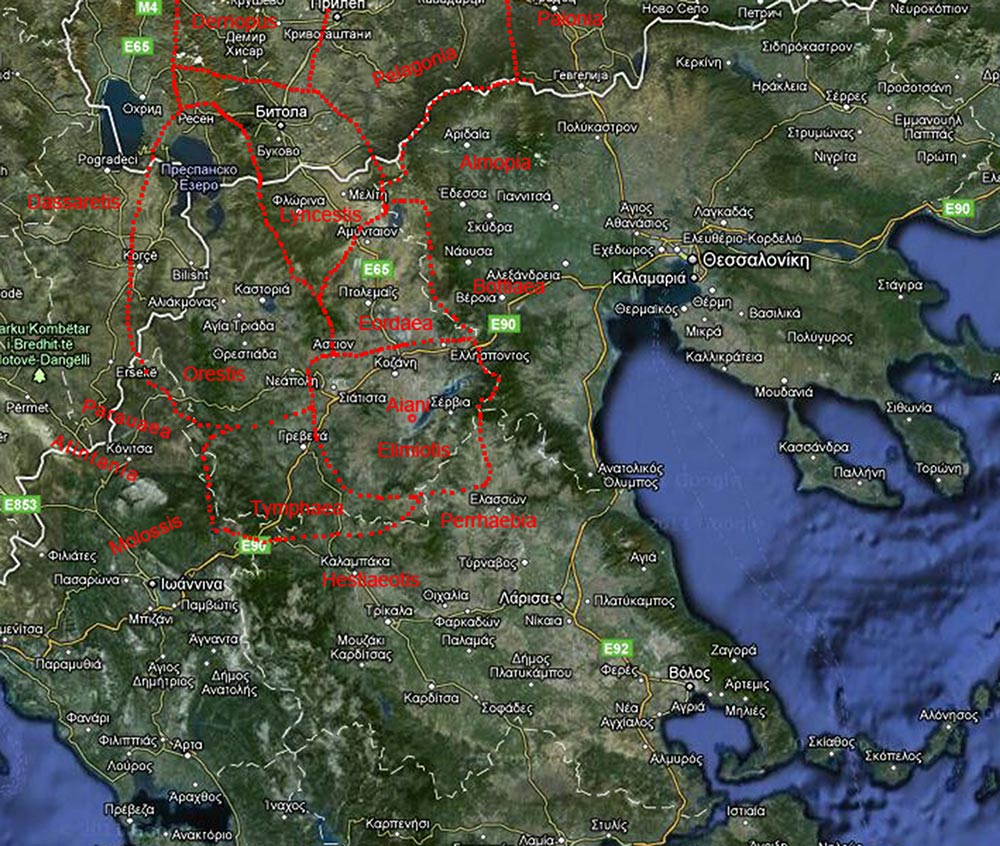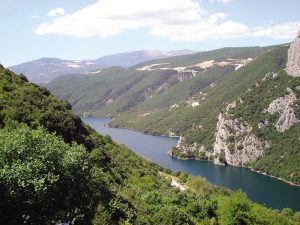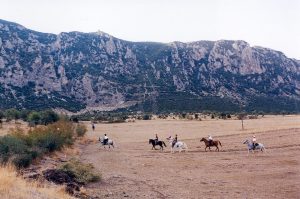Ιστορία - Αρχαιολογία

Η ΑΝΩ ΜΑΚΕΔΟΝΙΑ
ΙΣΤΟΡΙΚΟ ΚΑΙ ΓΕΩΓΡΑΦΙΚΟ ΠΛΑΙΣΙΟ
UPPER MACEDONIA
HISTORICAL AND GEOGRAPHICAL CONTEXT
Η σημερινή Δυτική Μακεδονία, περιοχή που ορίζεται από μικρούς και μεγάλους ορεινούς όγκους και διατρέχεται από τον ποταμό Αλιάκμονα, ανήκε στην Άνω -ορεινή- Μακεδονία των αρχαίων, η οποία εκτεινόταν πέρα από τα σημερινά ελληνικά σύνορα και περιλάμβανε τον ποταμό Εριγώνα, τις λίμνες Αχρίδα και Πρέσπες, καθώς και τις περιοχές μέχρι τα όρη Dautika, Babuna, Dren στα βόρεια.
Κατά τη διάρκεια της δεύτερης χιλιετίας π.Χ. υπήρξε σταθμός της πορείας του «πολυπλάνητου» έθνους των βορειοδυτικών ελληνικών φύλων, στα οποία ανήκαν οι Μακεδόνες και οι Δωριείς (Ηρόδοτος 1.56, 8.137-139, Θουκυδίδης 2.99). Ένας κλάδος τους, οι Αργεάδες Μακεδόνες, στους οποίους βασίλευαν οι Τημενίδες, απόγονοι του Τημένου γιου του Ηρακλή, μετά από διαδοχικές μετακινήσεις εγκαταστάθηκαν στην περιοχή του Ολύμπου. Στις αρχές του 7ου αι. π.Χ., με πρώτο γνωστό βασιλιά τον Περδίκκα, ίδρυσαν το κράτος των Αιγών. Από τις Αιγές, που σύμφωνα με μεταγενέστερη παράδοση ιδρύθηκαν από τον Αργείο Κάρανο τον 8ο αι. π.Χ., και αργότερα από την Πέλλα, γύρω στο 400 π.Χ., συνέχισαν την επεκτατική τους δράση για πολλούς αιώνες.
Η Άνω Μακεδονία μνημονεύεται για πρώτη φορά στον Ηρόδοτο και συγκεκριμένα σε δύο χωρία. Στο πρώτο (7.173.4) περιγράφει την εισβολή των στρατευμάτων του Ξέρξη στη Θεσσαλία: «ἐσβολὴν ἐς Θεσσαλοὺς κατὰ τὴν ἄνω Μακεδονίην διὰ Περραιβῶν κατὰ Γόννων πόλιν, τῇ περ δὴ καὶ ἐσέβαλε ἡ στρατιὴ ἡ Ξέρξεω». Στο δεύτερο (8.137-139) αφηγείται την περιπέτεια του ιδρυτή του βασιλείου των Αιγών και απογόνου του Ηρακλή, Περδίκκα, ο οποίος, μαζί με τους αδερφούς του, Γαυάνη και Αέροπο, «ἐξ Ἄργεος ἔφυγον ἐς Ἰλλυριοὺς (…) ἐκ δὲ τῶν Ἰλλυριῶν ὑπερβαλόντες ἐς τὴν ἄνω Μακεδονίην ἀπίκοντο ἐς Λεβαίην πόλιν».
Σαφέστερο διαχωρισμό μεταξύ άνω και κάτω Μακεδονίας συναντάμε στο Θουκυδίδη κατά την εξιστόρηση των συγκρούσεων των Αθηναίων και Λακεδαιμονίων στο βορειοελλαδικό χώρο, στη διάρκεια του λεγόμενου Πελοποννησιακού Πολέμου (2.99.1): «ἐς τὴν κάτω Μακεδονίαν, ἧς ὁ Περδίκκας ἦρχεν. τῶν γὰρ Μακεδόνων εἰσὶ Λυγκησταὶ καὶ Ἐλιμιῶται καὶ ἄλλα ἔθνη ἐπάνωθεν, ἃ ξύμμαχα μέν ἐστι τούτοις καὶ ὑπήκοα, βασιλείας δ’ ἔχει καθ’ αὑτά. τὴν δὲ παρὰ θάλασσαν νῦν Μακεδονίαν Ἀλέξανδρος ὁ Περδίκκου πατὴρ καὶ οἱ πρόγονοι αὐτοῦ, Τημενίδαι το ἀρχαῖον ὄντες ἐξ Ἄργους…». Και στα επόμενα δύο χωρία (1.59 και 2.100) ο διαχωρισμός είναι εξίσου σαφής: «καὶ καταστάντες <οι Αθηναίοι> ἐπολέμουν μετὰ Φιλίππου καὶ τῶν Δέρδου ἀδελφῶν ἄνωθεν στρατιᾷ ἐσβεβληκότων», «ἵππους δὲ προσμεταπεμψάμενοι ἀπὸ τῶν ἄνω συμμάχων».
Ο Στράβων (7, C326) κατονομάζει τέσσερις περιοχές που ανήκαν στην Άνω Μακεδονία, στην οποία οι Ρωμαίοι διατήρησαν καθεστώς «ελευθερίας» και αυτονομίας: «καὶ δὴ καὶ τὰ περὶ Λύγκον καὶ Πελαγονίαν καὶ Ὀρεστιάδα καὶ Ἐλίμειαν τὴν ἄνω Μακεδονίαν ἐκάλουν, οἱ δὲ ὕστερον καὶ ἐλευθέραν».Ο ίδιος (7, απόσπ.12), αναφερόμενος σε ποταμούς ως φυσικά γεωγραφικά όρια μεταξύ Θεσσαλίας, Ηπείρου και Μακεδονίας, τη συνδέει με τον Αλιάκμονα: «ὅτι Πηνειὸς ὁρίζει τὴν κάτω καὶ πρὸς τῇ θαλαττῇ Μακεδονίαν ἀπὸ Θετταλίας καὶ Μαγνησίας, Ἁλιάκμων δὲ τὴν ἄνω <Μακεδονίαν ὁρίζει> καὶ ἔτι τοὺς Ἠπειρώτας καὶ τοὺς Παίονας καὶ αὐτὸς καὶ ὁ Ἐρίγων καὶ ὁ Ἀξιὸς καὶ ἕτεροι».
Ο Λίβιος (45.29.9 και 45.30.6) αναφερόμενος στη διαίρεση της Μακεδονίας σε τέσσερις «μερίδες» μετά την ήττα του Περσέα στην Πύδνα το 168 π.Χ. από τους Ρωμαίους υπό τον Αιμίλιο Παύλο, ορίζει ως τέταρτη μερίδα την Άνω Μακεδονία «trans montem Boram», με έδρα την Πελαγονία και σύνορα την Ιλλυρία και την Ήπειρο. Αναφέρει σ’ αυτήν, ως κατοίκους, τους Εορδούς, Λυγκηστές, Πελαγόνες και προσθέτει, ως περιοχές, την Ατιντανία, την Τυμφαία και την Ελιμιώτιδα.
Από τη σύγχρονη ιστορική έρευνα εντάσσονται σ’ αυτήν η Ελιμιώτις με την Τυμφαία, η Λυγκηστίς, η Ορεστίς, η Πελαγονία με τη Δερρίοπο, η Εορδαία, η Ατιντανία και η Δασσαρήτις. Ομοφωνία μελετητών υπάρχει για τις περισσότερες από αυτές, ενώ οι ανένταχτες περιοχές στα δυτικά-βορειοδυτικά, κυρίως, της Άνω Μακεδονίας και γύρω από την Αχρίδα, μπορούν να συμπεριληφθούν στα «ἄλλα ἔθνη ἐπάνωθεν» του Θουκυδίδη (2.99), αν ήταν Μακεδονικές και όχι Ηπειρώτικες. Οπωσδήποτε, τμήματα της θεωρούμενης Δασσαρήτιδας, όπως και της Ατιντανίας, ανήκαν στην Ήπειρο, ενώ η περιοχή γύρω από τη Λυχνίτιδα-Αχρίδα μπορεί να ενταχθεί στην Άνω Μακεδονία. Για τα νέα αυτά όρια της Άνω Μακεδονίας, τα οποία αποτυπώθηκαν πάνω σε χάρτη της Γ.Υ.Σ. (Γεωγραφική Υπηρεσία Στρατού), βασιστήκαμε αφενός στην ιστορική έρευνα, παλαιότερη και νεότερη, και αφετέρου στα πορίσματα της νεότερης αρχαιολογικής-ανασκαφικής έρευνας, η οποία έδωσε νέα διάσταση στην πολιτισμική φυσιογνωμία της Μακεδονίας.
Είναι γνωστό, λοιπόν, ότι η Άνω Μακεδονία αποτέλεσε την αφετηρία, το ορμητήριο των βορειοδυτικών ελληνικών φύλων, τα οποία στο βόρειο χώρο ονομάστηκαν μακεδονικά και στο νότιο δωρικά, κατά τον Ηρόδοτο. Σύμφωνα με τον Ησίοδο (8ος αιώνας π.Χ.) ο Μακεδών ήταν αδελφός του Μάγνητα, γιοι και οι δυο του Δία και της Θυίας, κόρης του Δευκαλίωνα και αδελφής του Έλληνα. Κατά τον Ελλάνικο, συγγραφέα του 5ου αι. π.Χ., ο Μακεδών ήταν γιος του Αιόλου και εγγονός του Έλληνα. Η σημασία των αρχαίων αυτών πηγών, που δεν εξαντλούνται στις παραπάνω, έγκειται στο ότι μας δείχνουν με ποιον τρόπο οι νότιοι Έλληνες αντιλαμβάνονταν, ήδη από τα ομηρικά χρόνια, την ενότητα του ελληνικού έθνους, στο οποίο ανήκαν και οι Μακεδόνες -ας μη ξεχνάμε άλλωστε ότι οι θεοί κατοικούσαν στον Όλυμπο.
Η Άνω Μακεδονία με τα βασίλεια της Ελίμειας, Τυμφαίας, Εορδαίας, Ορεστίδας, Λυγκηστίδας, Πελαγονίας, Δερριόπου και άλλα «επάνωθεν» δεν είχε αποδυναμωθεί και απομονωθεί πολιτισμικά και κοινωνικά, όπως, δυστυχώς, αρχικά από έλλειψη αρχαιολογικών-ιστορικών δεδομένων είχε γραφεί. Αυτό αποδεικνύεται από την υψηλή χρονολόγηση, τον πλούτο, την ποιότητα και το χαρακτήρα των αρχαιολογικών ευρημάτων, μετά τη συστηματική έρευνα στην Αιανή και αλλού, που επέβαλε την επανεξέταση, κάτω από νέο πρίσμα, παλαιότερων αρχαιολογικών ευρημάτων.
Η αποκάλυψη στην Αιανή οικοδομημάτων και μνημειακών τάφων με ανάλογα κινητά ευρήματα, που δηλώνουν αυτόματα ενιαίο ελληνικό πολιτισμό και χρονολογούνται στα αρχαϊκά και κλασικά χρόνια, οδηγεί αναγκαστικά στη διαπίστωση ότι υπήρχαν οργανωμένες πόλεις με λαμπρή αρχιτεκτονική πολύ πριν από την ενοποίηση όλης της Μακεδονίας από τον Φίλιππο Β’ (359-336 π.Χ.), στον οποίο οι ιστορικοί απέδιδαν την ίδρυση των πρώτων πόλεων- αστικών κέντρων στην Άνω Μακεδονία. Παράλληλα, η αποκάλυψη αρχαϊκών και κλασικών επιγραφών, από τις πρωιμότερες του μακεδονικού χώρου, αποτελούν απτά τεκμήρια της εθνικής ταυτότητας των Μακεδόνων. Κατά τρόπο λογικό και αναγκαίο συμπεραίνουμε ότι, παράλληλα με τους Αργεάδες Μακεδόνες της Κάτω Μακεδονίας, τα «επάνωθεν», κατά το Θουκυδίδη, ελληνικά βασίλεια της Άνω Μακεδονίας χαρακτηρίζει τον 6ο και 5ο αι. π.Χ. υψηλό βιοτικό και πολιτιστικό επίπεδο.
Οι σύγχρονοι νομοί Καστοριάς, Φλώρινας, Κοζάνης και Γρεβενών ανήκαν στην Άνω Μακεδονία, σύμφωνα με το διαχωρισμό της Μακεδονίας από τους αρχαίους συγγραφείς σε ορεινή – Άνω– και πεδινή –Κάτω. Η Άνω Μακεδονία, λοιπόν, απαρτιζόταν από ιδιαίτερα βασίλεια που τα αποτελούσαν συγγενικές φυλετικές ομάδες – έθνη με κοινωνικό και πολιτικό σύστημα, το οποίο βασιζόταν κατά τους πρώτους αιώνες της εμφάνισής τους στις αρχές του αγροτοποιμενικού βίου. Μέσα στα γεωγραφικά όρια των παραπάνω νομών κατοικούσαν Ορέστες, Λυγκηστές, Εορδοί, Τυμφαίοι, Ελιμιώτες, οι οποίοι μέχρι την ύστερη αρχαιότητα, παρόλη την ενοποίηση του μακεδoνικού βασιλείου, την ανάπτυξη των πόλεων ως διοικητικών κέντρων και τη ρωμαϊκή κατάκτηση, διατήρησαν τη φυλετική τους οργάνωση, όπως φαίνεται και από τις αναφορές του εθνικού της περιοχής στον αυτοπροσδιορισμό των κατοίκων τους, π.χ. Μακεδών Ελιμιώτης, Μακεδών Εορδαίος κτλ. Η οριστική ενοποίηση επιτεύχθηκε χάρη στην πολιτική και στρατιωτική ιδιοφυΐα του Φιλίππου Β’, ο οποίος με συνεχείς νίκες και άριστες διπλωματικές μεθόδους πέτυχε την ενσωμάτωση των διαμερισμάτων της Άνω Μακεδονίας, την κατάταξη των ευγενών στην τάξη των εταίρων, και συνεπώς την εξασθένηση και κατάργηση των ηγεμονικών οίκων. Η προσάρτηση της Ελίμειας, όπως και των άλλων «επάνωθεν» περιοχών, πραγματοποιήθηκε μάλλον ειρηνικά και εδραιώθηκε μετά την επιτυχή απώθηση και συντριβή των Ιλλυριών τόσο από τον Φίλιππο (358 π.Χ.) όσο και το στρατηγό του, τον Παρμενίωνα (356 π.Χ.), ο οποίος, όπως και πολλοί άλλοι στρατηγοί, καταγόταν από την Άνω Μακεδονία και συγκεκριμένα από την Πελαγονία, βορείως του Εριγώνα, σημερινού Cerna.
Είναι βέβαιο ότι η συμβολή των «επάνωθεν» στη νικηφόρα εκστρατεία ως τις Ινδίες, που έγινε με τη συμμετοχή όλων των Ελλήνων «πλην Λακεδαιμονίων», υπήρξε καθοριστική. Από τις έξι ταξιαρχίες του Μ. Αλεξάνδρου στα 330 π.Χ. τρεις προέρχονταν από την Άνω Μακεδονία, δηλαδή την Ελίμεια, την Ορεστίδα μαζί με τη Λυγκηστίδα και την Τυμφαία (Διόδωρος 17. 57. 2). Επιπλέον διοικούνταν για πολλά χρόνια από ταξίαρχους (ο Κοίνος Πολεμοκράτους, Ελιμιώτης, ο Περδίκκας Ορόντου από την Ορεστίδα και ο Αμύντας Ανδρομένους και Πολυπέρχων Σιμμία αργότερα από την Τυμφαία), μέλη των βασιλικών οίκων της Άνω Μακεδονίας. Ταξίαρχοι, όπως ο Κρατερός, διοικούσαν ταξιαρχίες που προέρχονταν από άλλες περιοχές. Για τις τρεις μόνον από τις έξι ταξιαρχίες χρησιμοποιείται ο όρος ασθέταιροι. Το όνομα, που δόθηκε από το Μ. Αλέξανδρο, συνδεόταν με ένα είδος πολεμικών τιμών για εξαιρετικές υπηρεσίες και αφορούσε τους Μακεδόνες από την Άνω Μακεδονία, οι οποίοι ξεχώριζαν για τις ικανότητές τους σε σκληρές δοκιμασίες. Κατά το 2ο αι. π.Χ. αι., και συγκεκριμένα μετά την ήττα του Περσέα στην Πύδνα το 168 π.Χ., σύμφωνα με το διακανονισμό του Αιμιλίου Παύλου στην Αμφίπολη η Άνω Μακεδονία αποτέλεσε, όπως ήδη αναφέραμε, την τέταρτη μερίδα. Το ίδιο καθεστώς διατηρήθηκε πιθανότατα και μετά την ήττα του σφετεριστή του μακεδονικού θρόνου Ανδρίσκου στα 148 π.Χ. από τα ρωμαϊκά στρατεύματα, που είχε ως συνέπεια και τη μεταβολή της Μακεδονίας σε ρωμαϊκή επαρχία (provincia Macedonia), με έδρα τη Θεσσαλονίκη.
Γεωργία Καραμήτρου-Μεντεσίδη, Δρ Αρχαιολόγος
Present-day Western Macedonia, a region bounded by mountain ranges of varying size and traversed by the river Haliakmon, belonged to the mountainous Upper Macedonia of antiquity, which extended beyond the borders of modern Greece and took in the river Erigon, lakes Achris (Achrid) and Prespa and the lands bounded by the Dautika, Babuna and Dren mountains to the north (fig. 1).
During the second millenium BC this region was a stopping-point in the migrations of the ‘far-wandering’ family of north-western Greek tribes, which included the Macedonians and the Dorians (Herodotus 1.56, 8.137-139; Thucydides 2.99). After a series of migrations, one branch of this family, the Argead Macedonians, who were ruled by the Temenids, descendants of Temenos, the son of Heracles, settled in the area around Olympus. In the early 7th century BC, under their first known king, Perdiccas, they founded the state of Aegae. From Aegae which according to a later tradition was founded by the Argive Karanos in the 8th century BC and later from Pella, in about 400 BC, they continued to expand outwards for many centuries.
Upper Macedonia is mentioned for the first time in Herodotus – in two passages in particular. In the first (7.173.4) he describes the invasion of Thessaly by Xerxes’ army: ‘There was another way into Thessaly through upper Macedonia and Perrhaebea, near Gonnus – the pass, in fact, by which Xerxes’ army actually did come in.’ In the second (8.137-139), Herodotus narrates the adventures of Perdiccas (a descendant of Heracles and founder of the kingdom of Aegae), who, together with his brothers Gauanes and Aeropus, ‘had been expelled from Argos and had taken refuge in Illyria. Thence they crossed into upper Macedonia and went to the town of Lebaea’.
A clearer distinction between Upper and Lower Macedonia is provided by Thucydides in his narration of the clashes between the Athenians and the Spartans in northern Greece during the so-called ‘Peloponnesian War’ (2.99.1): ‘This force…prepared to descend from the mountains into the kingdom of Perdiccas in Lower Macedonia. In the interior there are Macedonians also – the Lyncestians, the Elimiots and other tribes – who are allies and dependants of the Macedonian King, but who have separate kings of their own. The part of the country on the sea-coast, known as Macedonia, was first acquired by Alexander, the father of Perdiccas, and by his ancestors, who were originally Temenids from Argos …’ In the following two passages the distinction is equally clear: ‘(The Athenians) established themselves on the coast and made war in cooperation with Philip and the brothers of Derdas, who had invaded the country from the interior’ (1.59) and ‘The Macedonians…sent for further reinforcements of cavalry from their allies in the interior’ (2.100).
Strabo (7, C326) names four areas in Upper Macedonia that retained a certain degree of ‘freedom’ and autonomy under the Romans: ‘And in fact the regions about Lyncus, Pelagonia, Orestias and Elimeia used to be called Upper Macedonia, though later on they were by some also called Free Macedonia’. While discussing the natural river boundaries between Thessaly, Epirus and Macedonia, the same author (7, frag. 12) links Upper Macedonia with the river Haliakmon: ‘The Peneius forms the boundary between Lower Macedonia, or that part of Macedonia which is close to the sea, and Thessaly and Magnesia; the Haliakmon forms the boundary of Upper Macedonia; and the Haliakmon also, together with the Erigon and the Axios and another set of rivers, form the boundary of the Epeirotes and the Paeonians.’
Referring to the Roman division of Macedonia into four merides (administrative districts) after the defeat of Perseus by Aemilius Paulus at Pydna in 168 BC, Livy mentions Upper Macedonia (‘trans montem Boram’) as being the fourth meris, centred on Pelagonia and bounded by Illyria and Epirus. He states that it was inhabited by the Eordoi, the Lyncestae and the Pelagones and included the regions of Atintania, Tymphaea and Elimeia.
According to modern historical research, Upper Macedonia consisted of the regions of Elimiotis with Tymphaea, Lyncestis, Orestis, Pelagonia with Derriopus, Eordaea, Atintania and Dassaretis. Most researchers agree on the inclusion of most of these areas, while those areas mainly to the north and north-west of Upper Macedonia and around Achrid that have not been included here could be allotted to the ‘other tribes in the interior’ mentioned by Thucydides (2.99), if indeed they were Macedonian and not Epirote. Certainly, part of Atintania and the area regarded as Dassaretis belonged to Epirus, while the area around Lychnitis-Achrid can be included within Upper Macedonia. The drawing of these new boundaries of Upper Macedonia (which have been charted on a map produced by the Hellenic Army Geographical Service) has been based partly on historical research, both older and more recent, and partly on the findings of recent archaeological excavations, which have added a new dimension to the cultural physiognomy of Macedonia (map 1).
It is a well-known fact, then, that Upper Macedonia was a starting-point, a base for further expansion of the north-western Greek tribes, who, according to Herodotus, were known as Macedonians in the northern part of the region and Dorians in the southern part. According to Hesiod (8th century BC) Makedon was the brother of Magnetas, and both were the sons of Zeus and Thyia, the daughter of Deucalion and sister of Hellen. According to Hellanicus, a writer of the 5th century BC, Makedon was the son of Aeolus and grandson of Hellen. The importance of these ancient sources, of which those just mentioned are but a small sample, lies in the fact that they show us how the southern Greeks perceived, from as early as the time of Homer, the unity of the greek nation, of which the Macedonians formed an integral part – let us not forget, moreover, that the gods dwelt on Olympus.
Upper Macedonia, with the kingdoms of Elimeia, Tymphaea, Eordaea, Orestis, Lyncestis, Pelagonia and Derriopus, as well as other ‘upper tribes’, did not become socially and culturally isolated and weakened, as was, unfortunately, formerly claimed by researchers working only with a scant supply of archaeological and historical evidence. This fact has been demonstrated by the early dating, wealth, quality and character of the finds yielded by the systematic research at Aiani and elsewhere, which has made it necessary to re-examine earlier archaeological finds from a new perspective.
The discovery at Aiani of buildings and monumental tombs with related movable finds that date from the Archaic and Classical eras and automatically point to a unified greek culture inevitably leads to the conclusion that organised cities with splendid architecture existed well before the unification of Macedonia as a whole under Philip II (359-336 BC), whom historians believe was responsible for founding the first cities/urban centres in Upper Macedonia. At the same time, the discovery of Archaic and Classical inscriptions, some of the earliest in the Macedonian region, provides tangible evidence of the ethnic identity of the Macedonians (figs 3, 4). The logical and inevitable conclusion is that, alongside the Argead Macedonians of Lower Macedonia, the Greek kingdoms of Upper Macedonia – Thucydides’ ‘upper tribes’ – also possessed a high standard of living and culture in the 6th and 5th centuries BC.
The modern Prefectures of Kastoria, Florina, Kozani and Grevena formed part of Upper Macedonia, according to the division of Macedonia by ancient writers into Upper Macedonia (the mountainous part) and Lower Macedonia (the plains) (map 2). Upper Macedonia, then, consisted of individual kingdoms occupied by related ethnic groups – nations with a social and political system that was based, in the early years of their existence, on an agricultural and pastoral way of life. Within the geographical boundaries of the above prefectures lived the Orestae, the Lyncestae, the Eordoi, the Tymphaeans and the Elimiotae, who, up until late antiquity – despite the unification of the Macedonian kingdom, the development of cities as administrative centres and the Roman conquest – preserved their tribal organisation, as can be seen from the references to the ethnic appellation ‘Macedonian’ in the names the inhabitants gave themselves, e.g. Makedon Elimiotes (an Elimiot from Macedonia), Makedon Eordaios (an Eordaean from Macedonia). The final unification of Macedonia was achieved through the political and military genius of Philip II, who, through a continuous series of victories and skilful diplomatic manoeuvres, succeeded in integrating the kingdoms of Upper Macedonia, enlisting the nobles into the ranks of the hetaeroi (the King’s Companions or elite cavalry) and therefore weakening and breaking up the ruling houses. The annexation of Elimeia, as of the other regions ‘in the interior’, probably took place peacefully and was consolidated after the successful repulsion and crushing defeat of the Illyrians both by Philip (358 BC) and his general Parmenion (356 BC), who, like many other generals, came from Upper Macedonia (from Pelagonia, to be precise, north of the river Erigon, now called the Cerna).
It is certain that the ‘upper tribes’ made a decisive contribution to the victorious campaign to India, in which all of the Greeks ‘except the Spartans’ took part. Of the six brigades that Alexander the Great deployed in 330 BC, three of them came from Upper Macedonia, i.e. Elimeia, Orestis together with Lyncestis, and Tymphaea (Diodorus 17.57.2). Furthermore, they were governed for a long time by brigadiers (Coenus, son of Polemocrates from Elimeia; Perdiccas, son of Orontes, from Orestis; and Amyntas, son of Andromenes, and later Polyperchon, son of Simmias, from Tymphaea), members of the royal houses of Upper Macedonia. Brigadiers like Craterus commanded brigades from other areas. Of the six brigades, three only were referred to by the term asthetairoi. This title, which was bestowed by Alexander the Great, was associated with a type of military honour awarded for exceptional services and was bestowed upon Macedonians from Upper Macedonia, who stood out for their resilience and endurance. In the 2nd century BC, and more specifically after the defeat of Perseus at Pydna in 168 BC, according to the settlement proclaimed by Aemilius Paulus at Amphipolis, Upper Macedonia became, as already noted, the fourth meris. This status was probably preserved even after the defeat by the Roman army of the pretender to the Macedonian throne Andriscus in 148 BC, which led to Macedonia becoming a Roman province (provincia Macedonia), centred on Thessaloniki.
Georgia Karamitrou-Mentessidi




